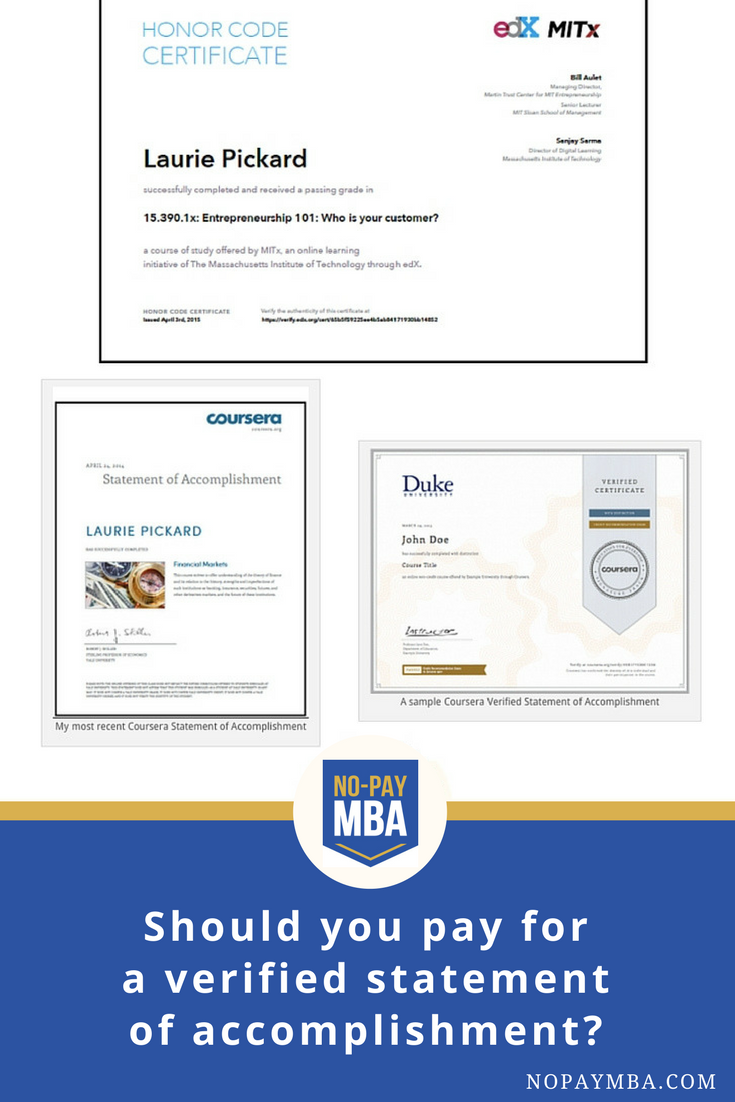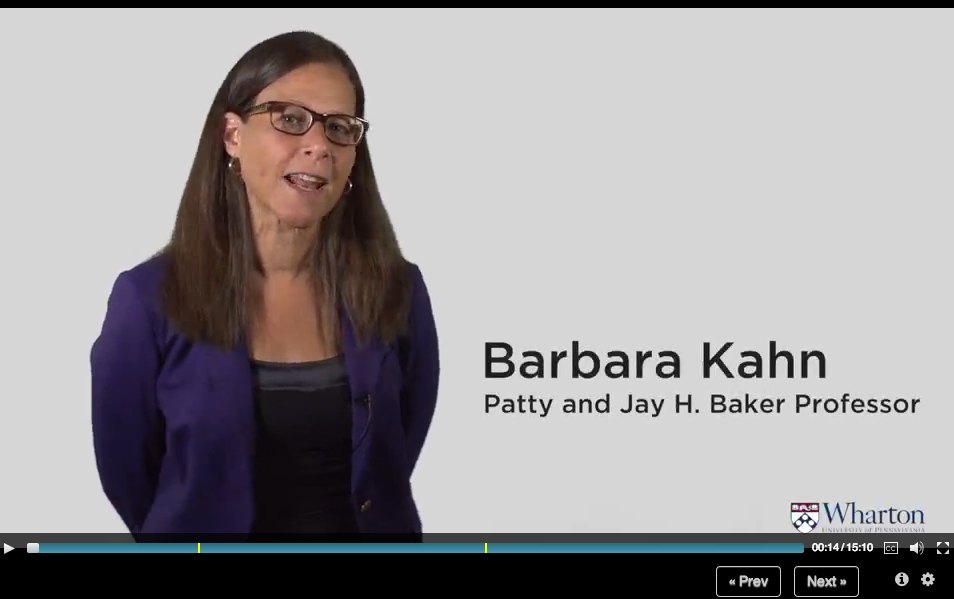by Laurie Pickard | May 24, 2014 | MOOC MBA Design, Thoughts on Higher Ed and Life

Recently, I’ve experienced a significant increase in the demands on my time. First, I’ve been busier at work. Second, I’ve taken on the job of managing the finances for the commissary at the US embassy in Kigali. Third, I’ve been revamping my site and have simultaneously been getting more requests for guest posts on other sites. And of course I haven’t stopped taking MBA courses. In fact, I am currently taking three MOOCs instead of my usual one to two. This jam-packed schedule has required some creative thinking on how to fit in course work on top of everything else, but I have been unwilling to drop any of my courses.
Here’s why I’m committed to sticking with all three courses and how I’m managing to fit everything in.
An Introduction to Marketing
Level of difficulty: Easy
Time per week: 2 hours
Strategy: Watch course videos and take quizzes in the evening after work
This course is part of Wharton’s foundation series; the others are Operations Management and Accounting, which I’ve already taken, and Corporate Finance, which I plan to take next time it’s offered. I’ve been impressed with the Wharton courses overall, and I’m committed to completing all four. Marketing is easier than the two other Wharton courses I’ve taken, but just as engaging. It is easy to fit it into my schedule, since the videos are entertaining enough to hold my attention even when I’m tired after work. In fact, my biggest complaint about this course so far is that the quizzes aren’t difficult enough – which, given my current scheduling constraints is probably not something I should be griping about.
Credit Risk Management
Level of difficulty: Difficult
Time per week: 4 hours
Strategy: One lesson or one problem set every day before work
Credit Risk Management is the course I should have dropped, but it’s my most difficult course, and I couldn’t bring myself to drop my hardest course twice in a row. Credit Risk Management covers how banks determine how much cash to keep in reserve, based on their borrowers’ risk of default. It’s given me some insight on how banking works, though it isn’t immediately obvious how I will apply any of this outside the classroom. Probably the most useful part of the course is that I’m learning R, a statistical analysis program, which I expect will come in handy next term, when I focus on data analysis.
This is one of those courses in which all assignments are due on the same day – the last day of the class. Which is great because it provides flexibility, but also terrible because it is too easy to fall behind. And the assignments are quite challenging to boot. To keep myself on track, I have started doing one short lesson or one problem set every morning before going to work.
Beyond Silicon Valley: Growing Entrepreneurship in Transitioning Economies
Level of difficulty: Moderate
Time per week: 2.5 hours
Strategy: Study at work – don’t worry, my boss knows!
Beyond Silicon Valley is the course that is most directly relevant to my work. I am an entrepreneurship specialist in a place that is quite far from Silicon Valley – both physically and in terms of the entrepreneurship landscape. This course discusses how governments, donors, anchor institutions, business incubators, and other players can create an ecosystem to support entrepreneurs. To make this course even more exciting, I’ve been in direct contact with the professor – no small feat in a course with thousands of enrollees from around the world. I’ve also been using this class as a laboratory for finding ways to engage more meaningfully through discussion forums. More on that in a future post.
Because the material in Beyond Silicon Valley is so obviously connected to my work – Rwanda is even used as an example! – I managed to get it included in my annual training plan. Which means that I can watch videos, post on forums, take quizzes, and write the required reflection journal entries during working hours. Score!
I’m hoping that some of these strategies might be helpful for others trying to squeeze online courses into a busy schedule. Feel free to post other methods you’ve come up with in the comments section of this post.
After these courses are done, I’m going on summer break!
by Laurie Pickard | May 17, 2014 | Community and Networking
I’m excited to present another student profile. Joris is from Utrecht, Netherlands. He reached out to me to describe an ambitious MOOC course load, focused on business and education – he’s taking more than 10 MOOCs at once. I was surprised to find out that Joris is simultaneously enrolled as a university student in not one but two degree programs! Below he shares his reasoning for taking so many courses and some great tips for MOOC students taking a full course load.
 Name: Joris Schut
Name: Joris Schut
Country of Origin: Netherlands
Lives in: Utrecht, Netherlands
Age: 24
Occupation: Student of Educational Science and Technology (masters) and Library- and Information Science (postgraduate studies)
What made you decide to take so many MOOCs when you are already enrolled in two degree programs?
“I am about to finish my studies so I still have a relatively large amount of time. Once I really start my career this time will very likely decrease by quite a bit. Therefore, this is the perfect time to do 10+ MOOCs parallel.
Although I am indeed in a degree programme, there is also a trend going on that ‘just having a degree’ is not enough. Any opportunity to something outside of the norm is good for your employability.”
How did you choose business and education as fields to focus on in your coursework?
“Business (including finance) is, together with teaching, computer science, humanities and the natural sciences, one of the big categories of courses that are offered. I did not see the pay-off for the humanities (not known for their great economic potential), the natural sciences (either too basic or not relevant for me), or computer science (there are other ways to learn this and the topics were too advanced for me at that time).
Teaching is fairly obvious as it is in line with my formal education. Furthermore, I think in order to be an advocate for online education you need to be an expert to some degree on this topic.
Joris’s Tips For Managing a Full MOOC Course Load
Tell others – colleagues, fellow students, friends, teachers and parents – what you are doing. Most people do not know what a MOOC is and might wonder what you are doing (especially if you do more than 2-3 MOOCs in parallel).
Get a buddy for each course you do. Knowing someone else who does the same course can motivate you. There is no real need to meet but just knowing who someone who is in the same course can help (at least for me).
In many platforms you can modify the playback speed. If you can manage to keep up it will save you time viewing lectures (I usually play videos between 1.25x and 2.00x.) Note this can have a downside as well: I sometimes think my real life professors are talking slow and I wish I could make them talk faster.
As with everything in life, balance your course load with your other activities as it is easy to spend all your time on MOOCs (there is just too much interesting stuff). What is a good balance will vary from person to person. Today, I decided to un-enroll from a couple upcoming courses as I realized it would conflict with other (real-life) activities.
Put the skills you learn on your CV instead of the individual courses (as you suggested in one of your previous posts).
Keep all the things you submitted for a peer assignment on your local computer. Instead of just submitting also make a copy in a text file (or any other format). This allows you to develop a portfolio which you can use later to show your work.
by Laurie Pickard | May 10, 2014 | Career Development, Courses, Platforms, and Profs, MOOC MBA Design
This post has been updated for 2015! See the new post here:
https://www.nopaymba.com/pay-verified-statement-accomplishment-mooc-update/

I’m currently taking three courses – two from Coursera and one from edX. All three come with a final course certificate, and all three offer an upgrade option for that certificate. In my two Coursera courses, the “Signature Track” option comes with a “Verified Statement of Accomplishment;” in my edX course, I can choose to enroll as an “ID-verified” student to get a “Verified Certificate of Achievement.”
So far, I haven’t spent any money on course certificates. Frankly, I wasn’t convinced the first time Coursera asked me to join a course’s Signature Track, and I still don’t see the added value.
What exactly is a verified course certificate?
Both Coursera and edX offer essentially the same product. For a fee ($49 on Coursera, $25 on edX), you can verify your identity by submitting a typing sample and snapping your image on a webcam. On subsequent logins, the system makes sure that you are the same student as before. At the end of the course you get a slightly snazzier-looking certificate than you otherwise would, with the word “verified” on it.
The value proposition for this product is based on four assumptions:
1. Course certificates have value to students.
2. Students will cheat to get these certificates, so there is value in ensuring that the person who holds the certificate is the same person who completed the course work.
3. Webcam photos and typing samples are an effective way of verifying a person’s identity.
4. Employers (or other third parties) know the difference between verified and non-verified course certificates.
Why I haven’t bought any course certificates
First, I’m skeptical that course certificates themselves are valuable. I can hardly imagine that I’ll present my course certificates to future employers for the same reason that I don’t list my individual courses from undergrad on my resume. The totality of the program of study is much more important than any individual class. That said, some type of proof of course completion is probably worth something, especially if you can aggregate individual certificates into something bigger.
If certification is valuable, then it does follow that some students will cheat to get them. However, I’m not at all convinced that verifying that the same student logs in again and again is a good way to prevent cheating. For example, a student who wants to cheat could get answers from a person sitting next to him or her, while still meeting the typing and webcam tests. It would even be possible for one person to do all the work for a course under someone else’s name.
But let’s leave that to one side. Let’s assume that the verification process is a good way of providing proof that person X really did the work for a given course. Even then, and even if employers care about course certificates at all, I highly doubt that they know the difference between verified and non-verified certificates.
Let’s say that employers do care. What the verified option currently tells you is that the person in question was able to complete a course without cheating. That might mean a lot if you knew that the course was really tough, or if mastering the material was essential for some particular purpose. But for any old course, if I was able to sit through a few videos, answer a couple of quiz questions, and post ungraded comments on a discussion forum, do you as an employer really care that I was able to do that without having to cheat? I’m not buying it.
A course certificate I would pay for
If MOOC providers want to make money from course certificates they could do a few things.
1. Don’t give away any course certificates for free. The marginal difference between having a certificate and having no certificate is greater than the marginal difference between a regular certificate and an identity-verified certificate. There are probably more people willing to pay for any kind of certificate at all when certificates aren’t free than there are people who will pay for a premium certificate when regular certificates are free.
2. Include course difficulty or relevance ratings on the course certificate. Anyone who has taken a few MOOCs knows that the level of difficulty varies enormously from course to course. Likewise, coursework varies from immensely practical to merely interesting. Students know the difference. It would be easy enough to crowd source difficulty and relevance ratings to give a better indication of how valuable a given course certificate is.
3. Focus on strings of courses that demonstrate professional competency. Completion of a series of courses has a much greater potential to signal mastery than a single course completion certificate. edX has started to group courses in its xSeries. Coursera has begun to do the same with its Specializations. The models here are slightly different. edX charges for the courses themselves at about $100 per course, while Coursera charges only for the verified Statements of Accomplishment. I am excited to take a set of business courses from one of these providers, but so far none have been released. (I’m still waiting on MIT’s Supply Chain Management series through edX.)
4. Market aggressively to teach employers the value of course certificates. A certificate I would be happy to pay for would be one that employers find interesting or impressive. Even more valuable would be a certificate that signals to an employer, “If this person was able to finish this series of courses, then she must be capable of doing work in ______________________________ (insert field).”
I’d like to hear what others think about this. Do you pay for course certificates? If so, why? If not, why not?

by Laurie Pickard | May 2, 2014 | Most popular posts, Thoughts on Higher Ed and Life

Ladies, the numbers don’t look good. Though there isn’t much data specific to business courses, those studies that have been done on MOOC enrollment rates point to an overall trend of many more men than women taking advantage of free online courses. The numbers vary, but the story is largely similar. In one study of MOOC users, female students were 41% of the population; in another, they were only 36%. EdX recently released a profile of its users, only 29% of whom are women. As one article summarized the research, “students tend to be young, well-educated males who are trying to advance in their jobs.”
I started thinking about this topic when I clicked on the first video lecture for Wharton’s Introduction to Marketing and found myself surprised to see a female professor. I’m not sure why it didn’t occur to me before that moment, but I realized that almost all of my MOOC professors have been men. I did one short course on human resources taught by a woman, and there were a couple of brief units taught by women in my course on international organizations management, but the vast majority of my courses so far have been taught by men. This got me thinking about women’s participation in MOOCs, both as students and as professors.
Though I didn’t find any formal research, preliminary evidence suggests that the stats among MOOC professors are even worse than those among MOOC students. Out of curiosity, I conducted my own informal survey of Coursera’s Business and Management course offerings. The 62 courses I found included the following:
| Business courses taught by one man |
42
|
| Business courses taught by two or more men |
11
|
| Business courses taught by mixed gender groups |
8
|
| Business courses taught by one woman |
1
|
| Business courses taught by a group of women |
0
|
So there you have it. Women are under-represented in business MOOCs, just as they are in business school generally.
Now that I’ve shared these disheartening statistics, let me tell you why I’m optimistic about the potential of business MOOCs to be a great boon to women.
1. MOOCs are so new that these numbers could easily change. The overall trend may be that more MOOC students are men, but at least in my Accounting course last year, the gender gap was markedly less than in the studies I mentioned previously.
2. The economic arguments that keep some women out of MBA programs do not apply to MOOCs. Some women who choose not to go to traditional business school may be making the right financial choice, especially if they want to prioritize family, have flexibility in their careers, or take any extended breaks from working. Women who want to learn business skills without going deeply into debt – especially if they don’t plan to put their careers before other priorities – may find that a MOOC-based education makes more sense for them than a traditional degree program.
3. For women who do intend to apply to B-school, taking a few MOOCs can be a great way to build confidence prior to enrolling.
4. The number of women-owned businesses grew by 41% between 1997 and 2013. A regular MBA might not be the greatest investment for a woman who wants to start her own businesses. Conversely, free online education can provide what an entrepreneur needs to get started without the debt to weigh her down.
Have I convinced you? If so, why not enroll in a MOOC today? We need to get our numbers up!








